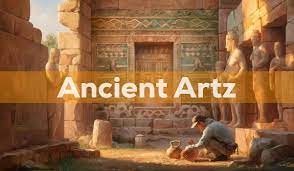
Ancient Artz Alchemy: Symbols of the Past
Throughout the history of human civilization, ancient art has played a profound role in shaping cultures, identities, and belief systems. From cave carvings to sacred geometries, these artistic expressions go beyond mere decoration. They are encoded messages, spiritual markers, and cultural time capsules left by those who lived millennia ago. In this exploration of Ancient Artz Alchemy, we’ll uncover the deep symbolism, spiritual influence, and transformative power of these timeless creations—and how understanding them today opens doors to the past and future.
Understanding the Concept of Ancient Artz
The term ancient art refers to the symbolic and spiritual artwork created by early civilizations. Unlike modern art, which is often focused on personal expression or aesthetics, ancient art was rooted in ritual, storytelling, and sacred purpose. From Egyptian hieroglyphics and Greek pottery to Indian mandalas and Aztec murals, these forms were tools for education, worship, and power.
The “z” in artz represents a reimagined perspective—a modern lens looking back at traditional forms, reinterpreting them for the digital age without losing the essence of their origin. This evolution appeals to today’s creative seekers, designers, spiritualists, and researchers who want to connect ancient wisdom with contemporary relevance.
Sacred Symbols and Hidden Codes in Ancient Artz
One of the most captivating elements of ancient art is the consistent use of symbols, many of which appear across different continents and periods. These recurring images suggest a universal language that early societies used to connect with higher realms or to record mystical truths.
Popular Symbols in Ancient Artz:
- The Spiral: Found in Celtic, Greek, and Native American art, representing evolution and the cosmic cycle.
- The Eye: Seen in Egyptian “Eye of Horus” and Buddhist depictions, symbolizing protection and awareness.
- The Mandala: Especially prominent in Hindu and Buddhist cultures, a spiritual diagram of the universe.
- The Labyrinth: Used in Minoan, Roman, and Christian traditions as a path to spiritual awakening.
- The Ankh: Egyptian symbol for eternal life, often seen in tombs and temples.
These are not just decorative shapes—they are energetic maps used for ceremonies, healing, and initiating higher states of consciousness. The placement, symmetry, and colors used in ancient art are often aligned with celestial movements or energy centers of the body, showing a deep integration of science, spirituality, and creativity.
Cultural Roots of Ancient Artz Across Civilizations
Every ancient culture has contributed to the vast library of visual and symbolic language. Let’s explore how a few major civilizations infused their daily life, architecture, and belief systems with art.
1. Egypt – The Sacred Language of Symbols
Ancient Egyptian art is defined by its structured style and highly symbolic imagery. The walls of tombs, pyramids, and temples are covered with carvings and paintings that narrate mythology, afterlife beliefs, and divine guidance. Colors were used with specific intent—blue for fertility, gold for divinity, and red for power.
2. India – Divine Forms and Sacred Geometry
India’s contribution to ancient art lies in its deep spiritual integration. Every temple, idol, or mural is created following precise geometry and mantra-infused rituals. The mandala, yantra, and chakra systems are not just art—they’re tools for meditation, alignment, and manifestation.
3. Mesoamerica – Cosmic Rituals in Art
The Aztecs and Mayans used art as a reflection of their calendar systems, deities, and rituals. Their murals, sculptures, and codices were often filled with detailed cosmic symbology that aligned with solar events and ritual sacrifice. Art was not entertainment—it was the medium of communication between humans and gods.
4. China – Nature, Taoism, and Balance
Chinese ancient art often featured ink paintings, ceramics, and scrolls that reflected Taoist philosophy—balance, harmony, and the flowing nature of energy. The dragon, phoenix, and yin-yang are core symbols that communicate balance between opposing forces.
Spiritual and Alchemical Aspects of Ancient Artz
Beyond cultural use, ancient art often carried alchemical knowledge—not just of turning metal into gold, but transforming the human spirit. In ancient times, art was a spiritual technology
that encoded frequencies, intentions, and truths. The shapes, sounds, and colors used were often designed to awaken higher states of being.
For example, sacred geometry, such as the Flower of Life or the Golden Ratio, is seen in temples, manuscripts, and even crop circles. These designs resonate with natural harmonic laws, and their use in architecture or visuals creates an environment conducive to healing, meditation, and consciousness expansion.
The “alchemy” in Ancient Artz Alchemy refers to this powerful fusion of symbolism, sacred intent, and energy. Today, many artists, architects, and spiritual seekers are returning to these roots—reinterpreting ancient techniques for modern transformation.
Modern Revival: Ancient Artz in Today’s Digital World
The renaissance of ancient art is well underway. Thanks to digital platforms, 3D printing, AR/VR, and AI-assisted design, we are witnessing a merging of past wisdom with futuristic tools. Artists and creatives are now revisiting ancient symbols and techniques, not to replicate but to evolve and activate them for the modern psyche.
You’ll find ancient art styles influencing:
- Tattoo culture with tribal, mandala, and sacred geometry patterns.
- Interior design through ancient motifs in modern spaces.
- NFT art collections that revive ancient gods, scripts, and designs in blockchain-backed forms.
- Mindfulness apps and meditation spaces that use mandalas and sacred visuals for cognitive alignment.
This modern embrace creates a cultural bridge—where ancient knowledge, once hidden in stone or scrolls, is now streaming across digital devices, inviting collective remembrance and creative transformation.
Why Ancient Artz Still Matter Today
The continued interest in ancient art is not just nostalgia or aesthetics—it’s a spiritual longing. As society faces fragmentation, many are turning toward holistic systems and timeless knowledge for grounding. Ancient art offers a language of unity, a mirror to our subconscious, and a guide to reconnect with nature, soul, and spirit.
By studying and applying the principles behind ancient symbols, geometry, and myth, individuals and communities can foster personal growth, cultural awareness, and spiritual depth.
Whether you’re an artist, a seeker, or someone exploring ancient history, engaging with ancient art is more than looking at old artifacts—it’s entering a dialogue with timeless intelligence.
Final Thoughts: Tapping into the Alchemy of Symbols
In conclusion, Ancient Artz Alchemy is not just about ancient images—it’s about decoding the symbols of the past to transform the present. These sacred visuals hold the keys to understanding our roots, unlocking human potential, and restoring balance in a chaotic world.
With the digital age offering us unprecedented access, we are now able to revive and reinterpret ancient art for healing, innovation, and connection. Whether through creative practice, meditation, or scholarly research, these timeless treasures offer paths back to the wisdom we desperately need today.
FAQs
1. What is the meaning behind the term “ancient artz”?
It refers to spiritually symbolic artwork from ancient civilizations, often infused with ritual and sacred intent.
2. Why do ancient symbols appear in multiple cultures?
Many cultures tapped into universal patterns and energies, leading to recurring sacred symbols worldwide.
3. How was ancient art used in daily life?
They were tools for storytelling, spiritual rituals, healing, and cosmic alignment in ancient societies.
4. Is there a spiritual benefit to studying ancient art today?
Yes, they can aid meditation and inner growth and reconnect us to universal wisdom.
5. Can ancient art inspire modern design and creativity?
Absolutely—many modern artists and designers incorporate ancient motifs for meaning and depth.
Conclusion
Ancient artworks are more than historical artifacts—they are timeless symbols carrying deep spiritual, cultural, and cosmic meanings. As we rediscover and reinterpret these sacred visuals today, they continue to inspire creativity, healing, and a deeper connection to our roots. By understanding their alchemy, we unlock a powerful bridge between the past and our evolving future.



